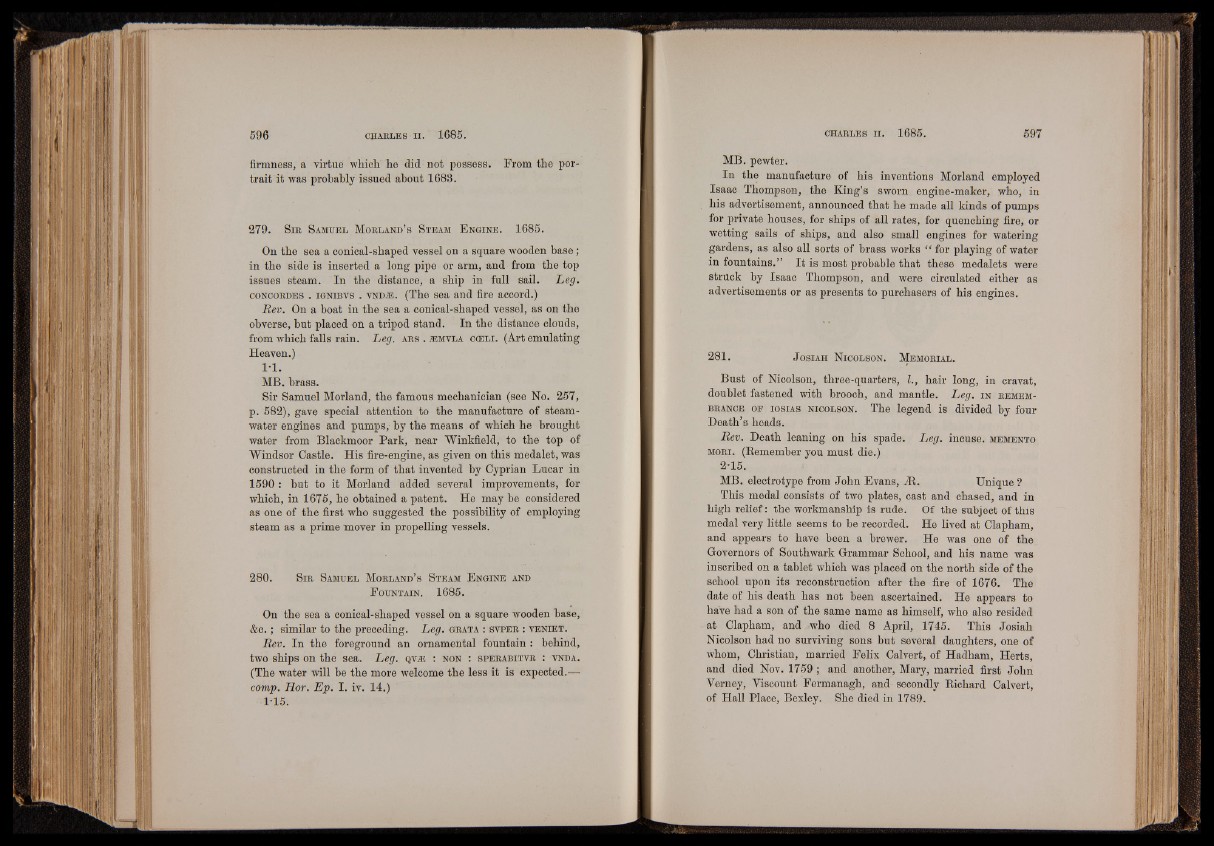
firmness, a virtue which he did not possess. From the portrait
it was probably issued about 1688.
279. S ir S am ije l M o r la n d ’s S team E n g in e . 1685.
On the sea a conical-shaped vessel on a square wooden base ;
in the side is inserted a long pipe or arm, and from the top
issues steam. In the distance, a ship in full sail. Leg.
Co n co r d e s . ig n ib v s . VNDiE. (The sea and fire accord.)
Rev. On a boat in the sea a conical-shaped vessel, as on the
obverse, but placed on a tripod stand. In the distance clouds,
from which falls rain. Leg. a r s . jemvla c ce l i. (Art emulating
Heaven.)
1-1.
MB. brass.
Sir Samuel Morland, the famous mechanician (see No. 257,
p. 582), gave special attention to the manufacture of steam-
water engines and pumps,- by the means of which he brought
water from Blackmoor Park, near Winkfield, to the top of
Windsor Castle. His fire-engine, as given on this medalet, was
constructed in the form of that invented by Cyprian Lucar in
1590 : but to it Morland added several improvements, for
which, in 1675, he obtained a patent. He may be considered
as one of the first who suggested the possibility of employing
steam as a prime mover in propelling vessels.
280. S ir S am u e l M o r la n d ’s S team E n g in e and
F o u n t a in . 1685.
On the sea a conical-shaped vessel on a square wooden base,
&c.; similar to the preceding. Leg. grata : sv p e r : v e n ie t .
Rev. In the foreground an ornamental fountain : behind,
two ships on the sea. Leg. qv.® : n o n : s p e r a b it v r : v n d a .
(The water will he the more welcome the less it is expected.—
comp. Hot. Ep. I. iv. 14.)
1-15.
In the manufacture of his inventions Morland employed
Isaac Thompson, the King’s sworn engine-maker, who, in
his advertisement, announced that he made all kinds of pumps
for private houses, for ships of all rates, for quenching fire, or
wetting sails of ships, and also small engines for watering
gardens, as also all sorts of brass works “ for playing of water
in fountains.” It is most probable that these medalets were
struck by Isaac Thompson, and were circulated either as
advertisements or as presents to purchasers of his engines.
281. J o s ia h N ic o l s o n . M em o r ia l .
Bust of Nicolson, three-quarters, I., hair long, in cravat,
doublet fastened with brooch, and mantle. Leg. in r em em b
r a n c e o f io s ia s n ic o l so n . The legend is divided by four
Death’s heads.
Rev. Death leaning on his spade. Leg. incuse, m em en to
m o r i . (Remember you must die.)
2-15.
MB. electrotype from John Evans, iR. Unique ?
This medal consists of two plates, cast and chased, and in
high relief: the workmanship is rude. Of the subject of this
medal very little seems to he recorded. He lived at Clapham,
and appears to have been a brewer. He was one of the
Governors of Southwark Grammar School, and his name was
inscribed on a tablet which was placed on the north side of the
school upon its reconstruction after the fire of 1676. The
date of his death has not been ascertained. He appears to
have had a son of the same name as himself, who also resided
at Clapham, and who died 8 April, 1745. This Josiah
Nicolson had no surviving sons but several daughters, one of
whom, Christian, married Felix Calvert, of Hadham, Herts,
and died Nov. 1759; and another, Mary, married first John
Verney, Viscount Fermanagh, and secondly Richard Calvert,
of Hall Place, Bexley. She died in 1789.